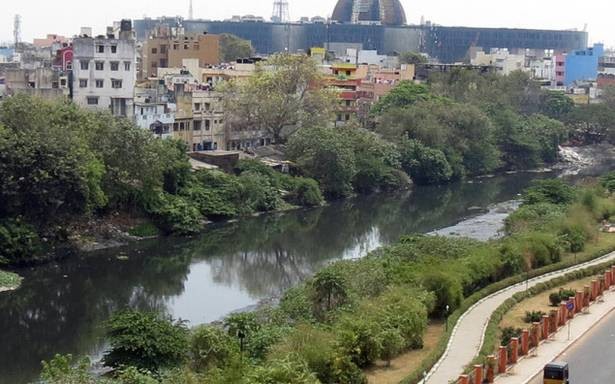Cooum River is one of the oldest river that is flowing in Chennai which was one of the major water source for Chennai in olden Days. Now Cooum River is the most contaminated river in Chennai.
Religion World will look at the rivers that call for immediate attention, because they have been polluted beyond repair. But the effort is to look at the river, its history, its use and how it was been brought to the state it is now. Our effort to write about these rivers is to enlighten the readers that they need attention and they can once again turn into lifeline for human race in their part. Today we bring, river flowing through Chennai, Cooum River.
Cooum River:
Cooum River, the very name reminds us of Chennai, the south India’s biggest and most happening city. In fact, Cooum is the only river that can be termed as Urban River since most of its journey is in Chennai city only, very little part is from district next to Chennai. With the city growing, the origins of the river is also now become part of the city.
Cooum is one of the most famous and very old river that is flowing in Chennai. It is great to know more about the Cooum River as it gives a good recognition to Chennai, to the people who are outside Chennai. Today, Cooum River is said to be one of the dirty river that is flowing in Chennai. The government is also making plans for cleaning the Cooum River which is a Herculean task.
Also Read : #KnowYourRivers : Noyyal River
Origin and Flow
The river cooum is a derivative of the Tamil literature word ‘Coovalan’; it denotes a person who is a specialist in the field of ground water, well water and stagnant water. It is one of the shortest classified rivers pouring into the Bay of Bengal. The river Cooum originates from the village Cooum, in Tiruvallur district, roughly 70 kms away from Chennai. It is currently a drainage course inside Chennai collecting the excess of 75 small tanks of sewers.
Once a fishing river is now a drainage tank because of Chennai’s population burst and expansion without due planning. In the olden Chennai when it was called as Madras, people were very much dependent on the Cooum River as the source of water. Due to some reasons later the drainage water was mixed with the Cooum River and this made the River contaminated. Even the colour of the Cooum is changed now because of the contamination.

Yet another story about its origin: The Cooum River has a very big history to go. There were lots of dependencies for the Cooum River in means of water requirement and also for the beauty of Chennai. The River was once said to have its origin from the Dharmapuri district. But now due to the Earth’s seismographic changes it has reduced its course till Tiruvallur. Thirty years have passed by since recreational boats were available for leisure boating. As part of Annual tourism exhibition used to take place tourists were taken in the water ways till 1985. At the source of the river two ancient Siva temples are there one in Tiruvirkolam and another in IlambaiyanKottur. These have been featured in the in the Thevaram sung by TirugnanaSambandar. Ancient documents states that Salvation can be reached by taking a holy dip in the Cooum River.
Mythology
Many years ago, before people started dumping garbage and sewage into Cooum, the river was even considered holier than Ganga. After all, it arose from the bow of Lord Shiva, according to the myth about its birth.
Before Lord Shiva was on a mission to destroy three asuras Tarakaksha, Kamalaksha and Vidyunmali, he forgot to pray to his son Lord Ganesha (legend goes that if you don’t worship Him before beginning a task, you may encounter hurdles your way). And so, Lord Shiva’s chariot’s bearing broke, the axle fell and lost balance. At this point, to regain balance, He placed the bow on the ground and I sprang up and washed His feet. Thus, the river was born and named Cooum (River underneath was called it Viruttaksheera Nathi).
While people here would detest and be ashamed to claim Cooum’s association with the city of Chennai, the river has connections so many – from the Cholas to the British. The inscriptions during that period are witness to how important Cooum River was. Take for instance, an inscription of Rajendra II mentions about selling land to create an exclusive feeder canal for me. Also, the inscription of Rajaraja in Shivapuram temple talks of a canal being dug to bring my water for abhishekam for the deity Lord Urogadamudaya Mahadevan.
Also Read : #KnowYourRiver : Vaigai River
Madras Thrived on Cooum Banks
But a couple of centuries ago, Cooum River is an important part of the growth of the city, luring people in power to settle down near my banks. Not just homes, but nearly everything that is notable in the city even today and those that have vanished over time, took shape on its river banks all those years ago.
Hospitals, hotels or movie halls were all clustered around its banks. When the East India Company wanted to build a port, they selected a site close to where Cooum joins the Bay of Bengal. Cooum river a perennial river and is mostly dry around Anna Nagar-Poonamallee area, depriving people of navigating throughout the year, unlike Buckingham Canal, where transportation was more active.
Like any other modern city, Chennai’s growth centred around Cooum’s meandering route in the heart of the city. The Dhubashis of Chennai prospered after they settled down beside the river in Egmore. The weavers who settled down in Chintadripet got enough water from the river.
Businessmen of East India Company and officers of the Raj started building their palatial houses and palaces in the verdant surroundings of the Cooum river, be it Marshalls Road, Casa Major Road or Montieth Road.
But the river’s crowning glory is Fort St George and even today, it is the seat of power. The Connemara Hotel, Spencer’s Plaza (though rebuilt after the fire) and Higginbothams are still inseparable companions of Cooum river.
Ecological issues
The river is narrow, placid, slow and meandering. The river is primarily fed by discharge from tank and water bodies and has seen a steady drop in freshwater over the years, a primary reason for its present-day condition. However, the core problem of the Cooum has been that due to the sand bar, the river mouth near the Napier Bridge gets blocked for most of the time, preventing the river water from draining into the sea. This has, eventually, made the river, in its 18-km-long stretch in the central district, a stinking cesspool.

Due to its narrowness and about 3,500 illegal hutments along its banks, it has not been recently desilted, which has closed it to river traffic. Per 2003 enumeration, about 9,000 families live along the river, in addition to 450 shops and commercial buildings. There are 700-odd points in the river bank where sewage flows straight into the river. There are 127 identified sewage outfalls into the river, out of which 85 are in use.
One of Chennai City’s dream project has come alive, the cleanup of the Cooum River. The government is also making a plan to clean the Cooum river but it is actually not very good to implement it soon because this is a very massive process and it involves lots of procedures. If this problem is rectified then there will not be any water problem for the people of Chennai.
Must Read : #KnowYourRiver : Kaveri River









